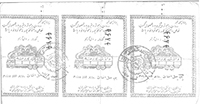This set of documents, captured in Kandahar in 2009, is associated with Haji Abdul Ghani Mohammad, a known Taliban financier and drug trafficker, and includes ordinary receipts for agricultural equipment, fuel, motorcycles, and, in one case, 349 bags of opium seed. In addition to ordinary customs receipts paid to the Afghan government, Mohammad was found with a logbook listing his opium sales, along with a detailed record of the zakat (an Islamic tax) that he paid to the Taliban. While some logbooks measure quantities in kilograms, many employ traditional rural forms of measurement including chaharak (about 1 kilo), mons (about 7 kilos) and kharwars (about 560 kilos). They sometimes compute the value using Pakistani Rupees, which are often referred to as Kaldars. Other times value is calculated in Afghani, the Afghan currency or in Tomans, an informal term for an Iranian currency unit. Some logbooks appear to incorporate crude codes or local slang, referring to heroin, for example as“powder” or simply“white,” and in some instances referring to drugs as“groceries.”
 Skip to content
Skip to content

